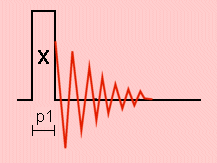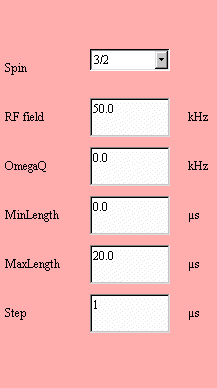AIM: Determination of the quadrupole coupling from a featureless NMR lineshape
Launch the one-pulse applet with Java Web Start (Not available).

The one-pulse sequence is the simplest NMR experiment. The corresponding one-dimensional nutation method allows us to determine the quadrupole coupling in a single crystal. Furthermore, for short pulse length p1, the central-line intensity is independent of the quadrupole coupling and proportional to p1. This excitation condition of quadrupole spins in a single crystal allows us to quantify the number of spins in the crystal. However the acquisition delay or the "dead time" of the NMR probe head modifies the line intensity.

The left part of the simulation panel indicates the physical parameters. It is preset for a typical experiment on a spin I = 3/2. You can introduce your own values.
MinLength: the first value of p1 in µs
MaxLength: the last value of p1 in µs
Step: the increment of p1 in µs
The following applet is initialized for the central-line intensity of a spin I = 3/2 in a single crystal excited by the one-pulse sequence. The experimental line intensities are identical to the simulated ones.
Help for selecting all the simulated data of the line intensity text area in a JDK1.1.8 applet.
